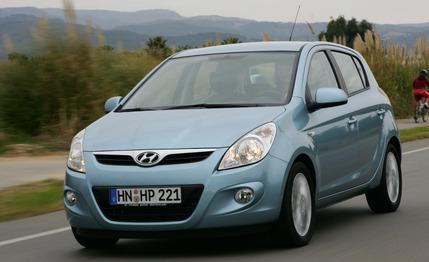
 First Drive Review
First Drive Review
Hyundai, we are pleased to have learned recently, can do upscale. From the traditional luxury of the front-wheel-drive Azera to the posh, rear-wheel-drive Genesis sedan and sporty Genesis coupe, the ambitious Korean company has clearly set its sights high.
Although those models show an attention to detail previously not achieved by the manufacturer, Hyundai is still about inexpensive, value-driven cars in the lower segments of the U.S. market. But this may change. Recognizing that premium doesn’t necessarily mean size and power anymore—witness the Mini Cooper—Hyundai is considering a U.S. launch of the i20. It is a subcompact developed almost entirely at Hyundai's European R&D center in Rüsselsheim, Germany, and produced in India.
Price and positioning are the sticking points. Although Hyundai Motor America doesn't think it could sell the i20 for more than the cost of the significantly larger Accent, the i20 is more advanced and expensive to build than the Accent, and much depends on what the mother company would charge HMA for each one. (Hyundai has already brought over the larger Hyundai Elantra Touring, which is sold as the i30 in Europe.)
Style Inside and Out
Initially, Hyundai wanted to bring the even smaller i10 here, but that tiny four-door was ultimately (and rightly) deemed too small. The i20, on the other hand, is sized right along with the Honda Fit and Toyota Yaris. The premium pocket car is a hot segment in Europe and Asia; Audi will join the battle with the A1, and even BMW could come out with its own car in this category. There are indications the U.S. market might wake up to the appeal of such compacts, too.
Considering that the headhunters of Hyundai Europe and Kia Europe are virtually raiding the design studios of every premium carmaker on the Continent, it is no wonder the i20 looks decidedly European. It was sketched by former BMW designer Thomas Bürkle, and although the front headlight and grille treatment likely won't arouse much public interest, we do like the i20's unorthodox, rakish side view.
The interior is dominated by an expanded center console and an eye-catching, curved line on the top of the dashboard. It certainly looks more premium than the Accent’s interior, but it must be said that the i20’s cabin isn’t as futuristic-looking as a Honda’s nor does it ooze the quality of an Audi’s.
Four-Speed Automatic Is a Downer, Diesel Is Not
Unfortunately, the 1.6-liter four-cylinder that would most likely be offered in the U.S. is a disappointment. Coupled with a five-speed manual transmission, Hyundai says the 124-hp four-banger can get the i20 to 62 mph in 9.5 seconds and up to 118 mph. Hook it to the dated four-speed automatic, however, and you can kiss speeding fantasies goodbye. Thus equipped, the sprint to 62 mph takes a claimed 11.4 seconds, and the i20 tops out at 112 mph. We didn't get a chance to verify these numbers, but you'd better have a really long stretch of road to get anywhere even close to the claimed top speed. Fuel mileage, as you might suspect, is not so good with this combo at 35 mpg in the combined European cycle versus 39 mpg with the manual. Hyundai is working on a dual-clutch automated manual transmission to replace the conventional slushbox, and it can't come soon enough.
The little Hyundai feels twice as quick with the optional (and likely to stay in Europe) 114-hp, 1.6-liter turbo-diesel, which makes a plump 192 lb-ft of torque at 1900 rpm. Coupled to a crisp six-speed manual exclusive to the oil burner, the i20 easily runs with the big guys on the road. At the same time, consumption is rated at 53 mpg in the European cycle. This engine is clearly the star of the powertrain lineup, but given diesel's lack of popularity in the States, we suspect the powerplant is not at the top of HMA's wish list. Also available in Europe are smaller 1.2-liter and 1.4-liter four-cylinders, which make 77 hp and 100 hp, respectively.
Comfortable enough for extended trips, the chassis tuning tends toward the safe side. The i20 tends to understeer, and the handling characteristics and the rubbery electric power steering are unlikely to inspire many drivers into tossing it around corners. If Hyundai decides to go ahead and export the i20, it would arrive in the 2010 calendar year.
Its European price position indicates it would come in at slightly less than the cost of a Honda Fit or Ford Fiesta. And the i20 could prove to Americans that Hyundai can make really good small cars, too.